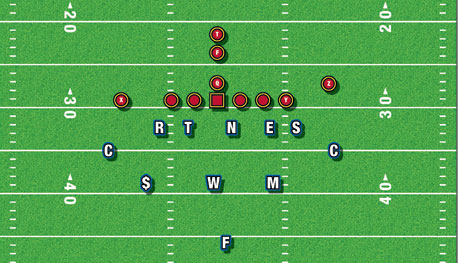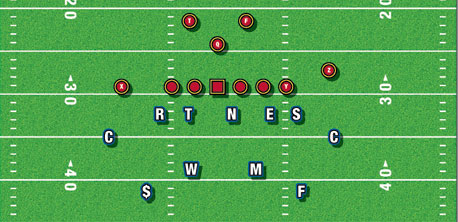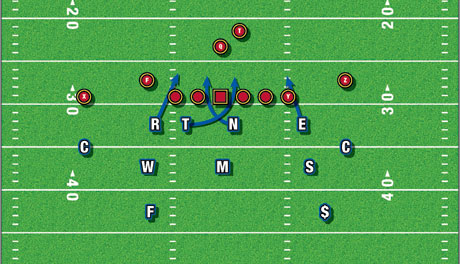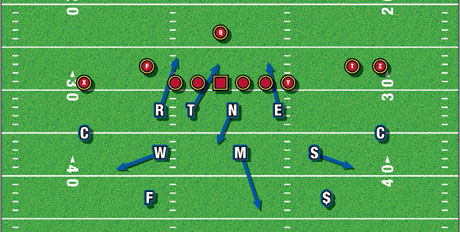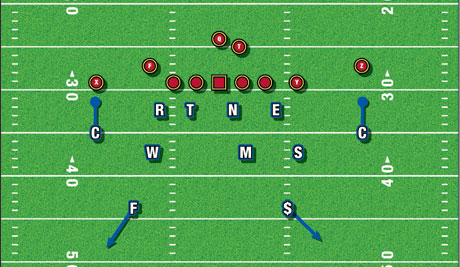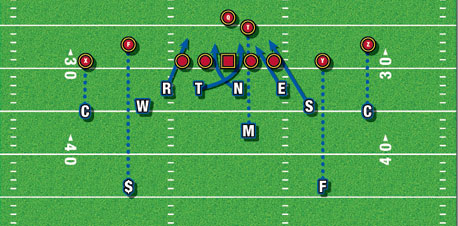AMERICAN FOOTBALL MONTHLY THE #1 RESOURCE FOR FOOTBALL COACHES
Article CategoriesAFM Magazine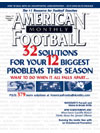
|
The Defensive Solution to Multiple Personnel / No Huddle Offensesby: Steve MonningerDefensive Coordinator, Middlebury College © More from this issue Traditionally, Middlebury College football has set their defensive calls in relation to the offensive personnel grouping on the field for that particular play. Most often, offensive personnel groupings dictate certain formations and favorite plays. Calling defenses based on offensive personnel groupings allows us to set the appropriate front and coverage, put our best personnel on the field and put our players in the best position for success. The Conflict Over the past several years, offenses have become more multiple in their formations out of particular personnel groupings. Running backs can line up as wide receivers. Tight ends can split out into the slot. Fullbacks can line up as a second TE. Typical 21 personnel can now readily align in one back, spread sets. Also, no huddle offenses can easily change formations and plays while on the ball. Therefore, the relationship between offensive personnel groupings and the formation or play is not as predictable as it once was. Additionally, some offensive alignments or formations give off “tips” that can alert us to the play the offense is about to run. Potential on the ball “tips” can include, but are not limited to, the depth of the running back, split of the WR and stance/level of the offensive line. These tips may tell us whether we are about to defend a run, pass or screen. But, how can we take advantage of that? With standard defensive play calling it can be problematic to change the defense while a no-huddle offense is on the ball. It is very difficult to come up with one call that can account for the multitude of formations and plays that you might face. Three years ago, we would utilize master checks that would take us into a base defense if we saw an untraditional formation or an obvious on the ball “tip.” But these master checks limited us to play only one defense for each formation for an entire game. The need to come up with a defensive call that allowed us to be flexible was more necessary then ever before. The Solution We came up with two types of calls that put our defense in the best position for success according to formation or special alignment. We use two types of matrices: “Money” and “Choice.” “Money” is a very flexible call that puts us in the best base defense according to a particular formation or alignment. The “Money” call allows us to be flexible in our coverages and is used primarily for first and second down calls. Once our players get the “Money” call from the sideline, our defensive captain will set the defense upon recognition of the formation. Our players would learn the multiple “Money” checks from a table that can be adjusted on a week-to-week basis (See Diagrams 1 through 6 for examples).
“Choice” is a concept that allows the defensive coach to make the last call according to a specific alignment or formation once the offense is set. “Choice’s” effectiveness is maximized when you can tell the play from a specific “tip” in the offense’s alignment. The “Choice” call allows us to be flexible in our coverage or blitz and is used primarily for critical situations such as third downs or red zone. Once our players get the “Choice” call from the sideline, we then tell them a code word that dictates whether we are playing zone, bringing a zone pressure or coming on an all out blitz. We will make our last call once we determine if we are getting a run “tip” or a pass “tip.” Our players would learn the multiple “Choice” checks from a table that can be adjusted on a week-to-week basis (See Diagrams 7 through 12 for examples of our “Choice” defense).
Conclusion Over the years, offenses have effectively adapted and evolved their personnel schemes to give defenses multiple looks and plays. As defensive coaches, it is our job to make sure that our defensive play calling can match that flexibility and put our players in the best position of success. As the relationship between offensive personnel groupings and formations and plays become more and more unpredictable, the need for systematic checks such as “Money” and “Choice” are critical to today’s modern defenses. The tables and diagrams seen in this article are just examples. You can develop these multiple check concepts using your own defenses to make it work for your particular scheme. WHAT IF? Q1. What if you face a trips formation as an offensive set? How does this affect your defensive checks? For the sake of this article, most of the diagrams show “two by two” offensive sets. Trips sets would not change the Money or Choice call. We may have to set our front differently to play an even digit coverage. We may have to alter our safety screw down techniques when we zone blitz. And we may have to put corners "over" in man-to-man concepts. But overall, the Money and Choice calls will still work. Q2. What if you face the Shotgun Spread with a great quarterback who thinks run before pass? What adjustments and defensive checks, if any, would you make? In our league, we see a lot of shotgun offenses and athletic QBs. If the quarterback is a run threat, then we will adjust our defensive ends' track/path to take care of the QB vs. zone read and triple option. We will also zone pressure or man blitz the back’s side to give the QB different looks. The last thing we want to see is an athletic QB to see a repetitive or consistent look on the edge. If he is a scramble threat on pass downs, then we will put more emphasis on cage/contain and we will utilize different pass rush games and spy techniques. Q3. What if the opponent is in your red zone? Do you have ‘Money’ or ‘Choice’ calls change based on down and distance or your opponent getting closer to your goal line? Definitely. Like many defenses, we are apt to bring more pressure in the red zone. The Money call usually takes care of our base defenses so we may not use this mechanism as much. But we may utilize the Choice concept or simply call out the man blitz or zone pressure that we want for that particular play. Field position, hash and down and distance tendencies from the scouting report usually take precedence over Money and Choice in this critical area of the field. About the Author Steve Monninger has served ten seasons as a coach for his alma mater, Middlebury College. Currently the Panthers DC and Linebackers Coach, he previously coached Middlebury’s O-Line, D-Line, and D-Backs. Monninger is also the athletic department’s Strength and Conditioning Coach. He played four years at linebacker and was captain his senior season. Questions? If you have any questions you can email the author at: SteveMonninger@AmericanFootballMonthly.com |
|
| HOME |
MAGAZINE |
SUBSCRIBE | ONLINE COLUMNISTS | COACHING VIDEOS |
Copyright 2024, AmericanFootballMonthly.com
All Rights Reserved


